The Ultrasonic Electrosurgical Devices Market is estimated to be valued at USD 5.4 billion in 2025 and is projected to reach USD 9.7 billion by 2035, registering a compound annual growth rate (CAGR) of 6.1% over the forecast period.
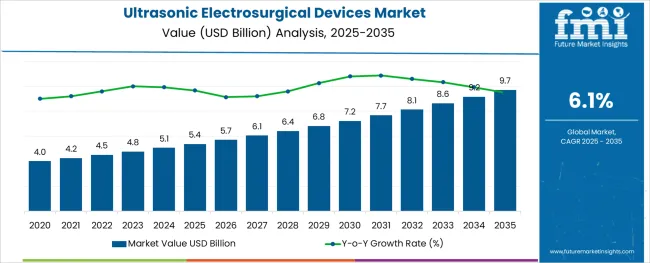
The ultrasonic electrosurgical devices market is exhibiting consistent growth as minimally invasive surgical procedures gain widespread acceptance and healthcare providers focus on enhancing surgical precision and efficiency. Advancements in ultrasonic energy delivery have improved cutting and coagulation capabilities, enabling better clinical outcomes and reduced patient recovery times.
Growing demand for cost-effective yet technologically advanced surgical instruments and an increasing volume of complex surgical procedures are contributing to the market’s expansion. Future growth is expected to be supported by rising healthcare infrastructure investments, surgeon preference for ergonomic and efficient tools, and technological innovations in device miniaturization and multifunctionality.
The interplay of improved patient safety standards, evolving reimbursement policies, and training initiatives for surgeons is paving the path for deeper market penetration across both developed and emerging healthcare systems.
The market is segmented by Product Type, Application, End-use, and Type and region. By Product Type, the market is divided into Consumables and Generators. In terms of Application, the market is classified into General Surgery, Cardiology, Gynecology, Urology, Bariatric Surgery, and Other Applications. Based on End-use, the market is segmented into Hospitals, Ambulatory Surgical Centers, and Other End-uses. By Type, the market is divided into Surgical Ablation Systems, High-intensity Focused (HIFU) Ablators, Magnetic Resonance-guided Focused (MRGFUS) Ablators, and Shock Wave Therapy Systems. Regionally, the market is classified into North America, Latin America, Western Europe, Eastern Europe, Balkan & Baltic Countries, Russia & Belarus, Central Asia, East Asia, South Asia & Pacific, and the Middle East & Africa.
The market is segmented by Product Type, Application, End-use, and Type and region. By Product Type, the market is divided into Consumables and Generators. In terms of Application, the market is classified into General Surgery, Cardiology, Gynecology, Urology, Bariatric Surgery, and Other Applications. Based on End-use, the market is segmented into Hospitals, Ambulatory Surgical Centers, and Other End-uses. By Type, the market is divided into Surgical Ablation Systems, High-intensity Focused (HIFU) Ablators, Magnetic Resonance-guided Focused (MRGFUS) Ablators, and Shock Wave Therapy Systems. Regionally, the market is classified into North America, Latin America, Western Europe, Eastern Europe, Balkan & Baltic Countries, Russia & Belarus, Central Asia, East Asia, South Asia & Pacific, and the Middle East & Africa.
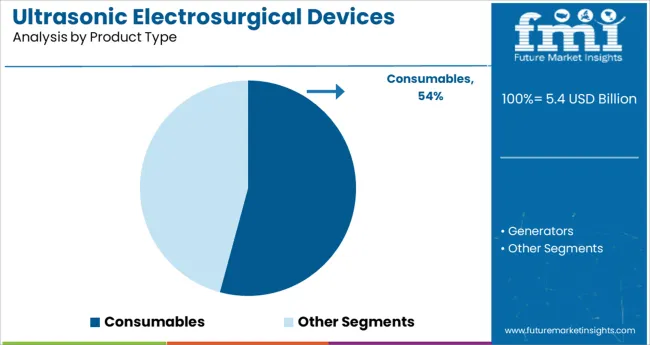
When segmented by product type, consumables are anticipated to account for 54.20% of the total market revenue in 2025, establishing themselves as the leading product segment. This leadership has been attributed to the recurring nature of consumable usage during surgical procedures and the requirement for sterile, single-use tips and blades to maintain safety standards.
Consumables have been increasingly preferred due to their direct impact on procedural efficiency, infection control, and cost predictability for hospitals. Innovations in material durability and precision engineering have enhanced the performance of consumables, encouraging repeat purchases.
Their relatively lower upfront cost compared to capital equipment and alignment with hospitals’ operational budgets have reinforced their dominant position in the product landscape.
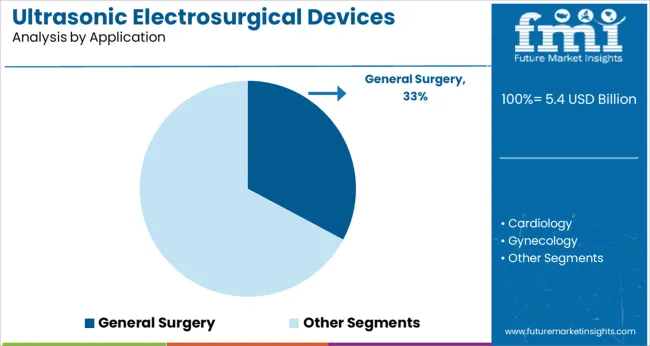
In terms of application, general surgery is projected to capture 32.80% of the market revenue share in 2025, ranking as the leading application segment. This prominence has been driven by the high procedural volume of general surgeries that benefit from ultrasonic technology’s versatility and efficacy in tissue dissection and hemostasis.
General surgery has seen expanded adoption of these devices owing to their ability to reduce intraoperative bleeding, minimize collateral tissue damage, and shorten operative times. The segment’s growth has also been reinforced by the availability of tailored ultrasonic tools for a variety of general surgical procedures and the growing emphasis on improving patient throughput in surgical departments.
Hospitals’ focus on standardizing surgical protocols and reducing postoperative complications has further strengthened the appeal of ultrasonic devices in this domain.
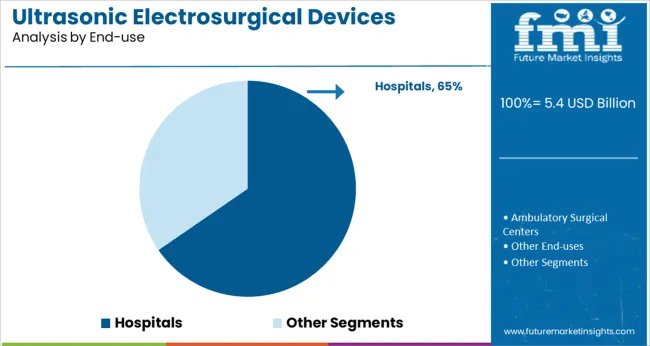
Segmented by end use, hospitals are expected to command 65.40% of the market revenue in 2025, retaining their position as the foremost end use segment. This dominance has been supported by hospitals’ ability to invest in advanced surgical technologies and their role as primary centers for both routine and complex surgical interventions.
Hospitals have been increasingly adopting ultrasonic electrosurgical devices to improve surgical outcomes, optimize resource utilization, and meet rising patient expectations for minimally invasive care. Their structured procurement processes, trained surgical staff, and access to multidisciplinary teams have facilitated widespread integration of ultrasonic technologies.
Moreover, hospitals’ need to comply with stringent safety and quality standards and their participation in surgical innovation programs have cemented their leadership in driving demand within the ultrasonic electrosurgical devices market.
As per the publication released by Future Market Insights - a market research and competitive intelligence provider, the market is currently valued at USD 5.4 Billion and is expected to become a USD 4.5 Billion market by the end of 2025. between 2025 and 2035, the market is expected to grow at a CAGR of 6.1%. The market is estimated to offer an absolute dollar opportunity of USD 3.5 billion during 2025 and 2035 and is likely to hit a valuation of USD 9.7 Billion by 2035.
The expanding elderly population, as well as an increase in the number of surgical procedures, are some of the primary drivers escalating the demand for ultrasonic electrosurgical devices during the forecast period. Ultrasonic electrosurgical technologies are becoming more popular as the concern for patient safety throughout complex surgical procedures grows.
The market is expected to grow due to the existence of a large number of companies and the rising prevalence of their strategic alliances for improving product portfolios. During the projected period, the frequency of surgical operations is expected to rise due to an increasing number of traffic accidents, an aging population, and increased healthcare spending in emerging economies.
The complex nature of Ultrasonic Electrosurgical equipment necessitates the use of qualified specialists for safely handling the instruments and performing the operations. The scarcity of such qualified and trained personnel may limit the demand. Furthermore, compared with conventional electrosurgical instruments, ultrasonic electrosurgery components are more expensive and less durable which has been constraining the market growth.
North America is likely to dominate the global market owing to the rising chronic ailments, preventive surgeries, minimally invasive surgeries, technological advancements, and the presence of large players in the region.
Meanwhile, the APAC market is likely to grow at the highest CAGR owing to the surge in the geriatric population, market expansion by key players, the rising adoption rate of technologically advanced products, growing healthcare expenditure, and increased reimbursement policies by the government.
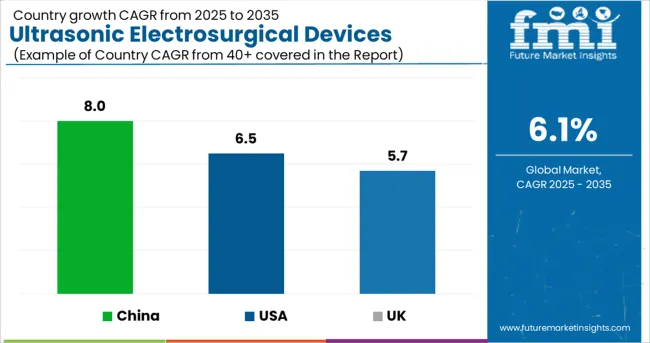
In 2024, the USA with over 25% share accounts for the largest Ultrasonic Electrosurgical Devices market globally. The market in the country is projected to expand at a CAGR of 6.5%. Between 2025 and 2035, the market is expected to surge with an absolute dollar opportunity of USD 1.4 billion. According to the American Heart Association, 7,85,000 Americans will experience their first heart attack this year, which will take the market forward.
During the forecast period, the market will be driven by favorable government policies, new product development, rising healthcare infrastructure expenditure, and a high level of patient knowledge about the presence of advanced treatment devices.
The region's ability to cater to a high level of innovation in the field of medical devices, as well as its growing burden of chronic disorders, rising preference for minimally invasive surgeries, and ability to cater to a high level of innovation in the field of medical devices, help it dominate the market.
The market in the UK is expected to reach a valuation of USD 9.7 Million by 2035. With a CAGR of 5.7%, the market is projected to gross an absolute dollar opportunity of around USD 5.4 Million from 2025 to 2035.
During the projected period, the Chinese market for Ultrasonic Electrosurgical Devices is expected to expand at a CAGR of 8%. Between 2025 and 2035, the market in the country is likely to generate an absolute dollar opportunity of USD 432.1. The higher adoption of modern technology, the rising frequency of chronic illnesses, the favorable reimbursement policies, the rising senior population, and the escalating preference for minimally invasive surgeries are contributing to this increase. Furthermore, major players have been investing in the healthcare sector of the country to address the unmet demand.
In 2024, ultrasonic electrosurgical consumables were the highest revenue-generating segment, which is projected to grow at a CAGR of 6%. The forecasted growth is significantly higher than the historical growth of just 4.1% during the period between 2020 and 2024.
The consumables segment is growing rapidly due to its easy disposable nature and low durability rate in comparison to ultrasonic electrosurgical generators. Furthermore, consumables are also reusable in a variety of treatment operations and have a limited usage cycle, both of which contribute to the segment's growth.
Ultrasonic electrosurgical devices find their largest utility in hospitals. The market revenue through hospitals is expected to grow at a CAGR of 6.5% during 2025 and 2035. The significant market growth through this segment is attributable to the factors like rising chronic diseases, increasing surgical procedures, and rising kidney and liver transplants. Furthermore, the rising availability of qualified medical professionals is driving segment growth.
The leading players in the Ultrasonic Electrosurgical Devices Market are increasing their Research and Development spending to fund the development of strategically advanced offerings. Furthermore, government funding, rising surgical procedures, technological advancements, advancing regulatory approvals, mergers and acquisitions, and a diverse product portfolio have contributed to the competitive environment in the market. To maintain their dominance in the global market of Ultrasonic Electrosurgical Devices Market, the leading players are projected to benefit from new product releases and the expansion of current operations in the untapped international market.
The key competitors in the Ultrasonic Electrosurgical Devices Market are Ethicon Endo-Surgery, Olympus Corporation, Medtronic, Misonix Inc., BOWA-electronic GmbH, Söring GmbH, Advanced Instrumentations, Reach Surgical, ITALIA MEDICA SRL, SonaCare Medical, and Miconvey.
The recent developments in the Global Ultrasonic Electrosurgical Devices Market are as follows:
Similarly, recent developments related to companies offering Ultrasonic Electrosurgical Devices have been tracked by the team at Future Market Insights, which are available in the full report.
The global ultrasonic electrosurgical devices market is estimated to be valued at USD 5.4 billion in 2025.
It is projected to reach USD 9.7 billion by 2035.
The market is expected to grow at a 6.1% CAGR between 2025 and 2035.
The key product types are consumables and generators.
general surgery segment is expected to dominate with a 32.8% industry share in 2025.






Full Research Suite comprises of:
Market outlook & trends analysis
Interviews & case studies
Strategic recommendations
Vendor profiles & capabilities analysis
5-year forecasts
8 regions and 60+ country-level data splits
Market segment data splits
12 months of continuous data updates
DELIVERED AS:
PDF EXCEL ONLINE
Ultrasonic Jewelry Cleaning Machine Market Size and Share Forecast Outlook 2025 to 2035
Ultrasonic Sealing Machines Market Size and Share Forecast Outlook 2025 to 2035
Ultrasonic NDT Equipment Market Size and Share Forecast Outlook 2025 to 2035
Ultrasonic Air Bubble Detectors Market Size and Share Forecast Outlook 2025 to 2035
Ultrasonic Pouch Sealers Market Analysis Size and Share Forecast Outlook 2025 to 2035
Ultrasonic Sensors Market Size and Share Forecast Outlook 2025 to 2035
Ultrasonic Homogenizer Machines Market Size and Share Forecast Outlook 2025 to 2035
Ultrasonic Cleaning Market Analysis - Size, Growth, and Forecast 2025 to 2035
Ultrasonic Flaw Detector Market – Trends & Forecast 2025 to 2035
Ultrasonic Flowmeters Market Trends – Growth & Forecast 2025 to 2035
Ultrasonic Pulse Velocity Tester Market Growth – Trends & Forecast 2018-2027
Ultrasonic Surgical Cutters Market
Ultrasonic Diathermy Market
Ultrasonic Testing Market
Ultrasonic Technology Market
Ultrasonic Tissue Ablation System Market
Ultrasonic Flow Meter Market
Ultrasonic Dissection Devices Market
Dual Frequency Ultrasonic Cleaner Market Size and Share Forecast Outlook 2025 to 2035
Dental Piezoelectric Ultrasonic Unit Market Trends and Forecast 2025 to 2035

Thank you!
You will receive an email from our Business Development Manager. Please be sure to check your SPAM/JUNK folder too.
Chat With
MaRIA